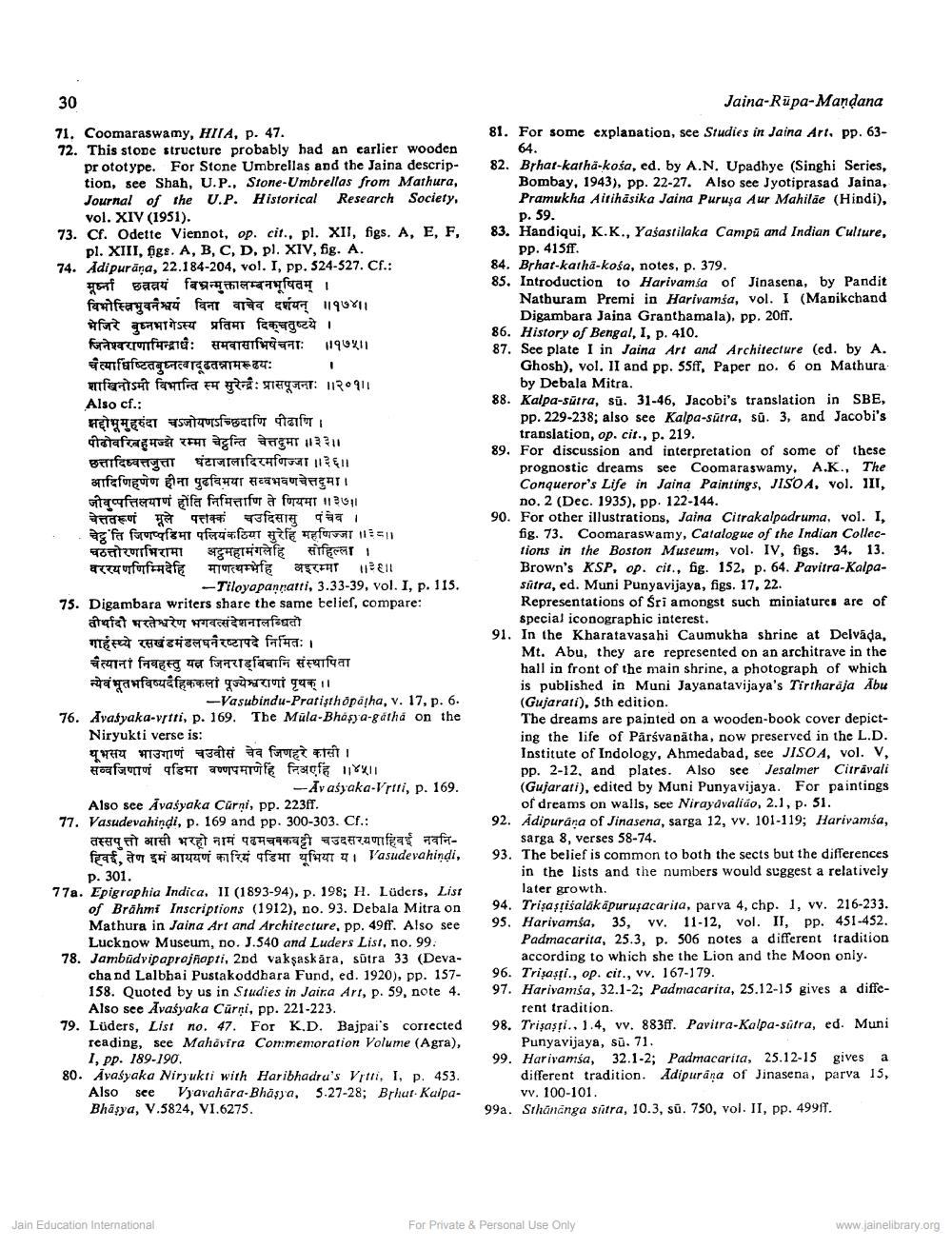________________
71. Coomaraswamy,HILA, p. 47. 72. This stone structure probably had an earlier wooden
prototype. For Stone Umbrellas and the Jaina description, see Shah, U.P., Stone-Umbrellas from Mathura, Journal of the U.P. Historical Research Society,
vol. XIV (1951). 73. Cr. Odette Viennot, op. cit., pl. XII, figs. A, E, F,
pl. XIII, figs. A, B,C,D. pl. XIV, fig. A. 74. Adipurana, 22.184-204, vol. I, pp. 524-527.cr.:
मूर्ना छत्रत्रयं बिभ्रन्मुक्तालम्बनभूषितम् । विभोस्त्रिभुवनश्वयं विना वाचेव दर्शयन् ॥१७४।। भेजिरे बुघ्नभागेऽस्य प्रतिमा दिक्चतुष्टये । जिनेश्वराणामिन्द्राधः समवासाभिषेचना: ॥१७५|| चैत्याधिष्टितबुध्नत्वादूढतन्नामरूढयः । शाखिनोऽमी विभान्ति स्म सुरेन्द्रःप्रासपूजनाः ॥२०१।। Also cf.: मद्दोभूमुहरुंदा चञ्जोयणऽच्छिदाणि पीढाणि । पीढोवरिबहुमज्झे रम्मा चेट्ठन्ति चेत्तदुमा ॥३३॥ छत्तादिध्वत्तजुत्ता घंटाजालादिरमणिज्जा ॥३६॥ आदिणिहणेण हीना पुढविमया सब्वभवणचेत्तदुमा। जीवुप्पत्तिलयाणं होंति निमित्ताणि ते णियमा ॥३७॥ चेत्ततरूणं मूले पत्तक्कं चउदिसासु पंचेव । चेदति जिणप्पडिमा पलियंकठिया सुरेहि महणिज्जा ।।८।। चठत्तोरणाभिरामा अट्ठमहामंगलेहि सोहिल्ला । वररयणणिम्मिदेहि माणथम्भेहि अइरम्मा हा
-Tiloyapannatti, 3.33-39, vol. I, p. 115. 75. Digambara writers share the same telief, compare:
तीर्थादौ भरतेश्वरेण भगवत्संदेशनालब्धिता गार्हस्थ्ये रसखंडमंडलघनरष्टापदे निर्मितः । चैत्याना निवहस्तु यत्न जिनराड्बिबानि संस्थापिता न्येवं भूतभविष्यदैहिककलां पूज्येश्वराणां पृथक् ।।
-Vasubindu-Pratisthópáha, v. 17, p. 6. 76. Avasyaka-vrtti, p. 169. The Mula-Bhosya-gatha on the
Niryukti verse is: यूभसय भाउगाणं चउवीसं चेव जिणहरे कासी। सम्वजिणाणं पडिमा वण्णपमाणेहि निअएहिं ॥४५||
-avasyaka-Vrtti, p. 169. Also see Avasyaka Curni, pp. 223ff. 77. Vasudevahindi, p. 169 and pp. 300-303. Cf.:
तस्सपुत्तो आसी भरहो नाम पढमचक्कबद्री चउदसरयणाहिबई नवनिहिवई, तेण इमं आययणं कारियं पडिमा भिया य। Vasudevahindi,
p.301. 77a. Epigraphia Indica. II (1893-94), p. 198; H. Lüders, List
of Brāhmi Inscriptions (1912), no. 93. Debala Mitra on Mathura in Jaina Art and Architecture, pp. 49ff. Also see
Lucknow Museum, no.J.540 and Luders List, no.99. 78. Jambūdvipaprojñapti, 2nd vaksaskāra, sūtra 33 (Deva
chand Lalbhai Pustakoddhara Fund, ed. 1920), pp. 157158. Quoted by us in Studies in Jaira Art, p. 59, note 4.
Also see Avaśyaka Cūrņi, pp. 221-223. 79. Lüders, List no. 47. For K.D. Bajpai's corrected
reading, see Mahavira Commemoration Volume (Agra),
I, pp. 189-190. 80. Avasyaka Niryukti with Haribhadra's Viti I, p. 453.
Also see Vyavahāra-Bhāsya, 5.27-28; Brhat.KalpaBhāsya,V.5824,VI.6275.
Jaina-Rupa-Mandana 81. For some explanation, see Studies in Jaina Art. pp. 63
64. Brhat-katha-kosa, ed. by A.N. Upadhye (Singhi Series, Bombay, 1943), pp. 22-27. Also see Jyotiprasad Jaina, Pramukha Aitihasika Jaina Puruşa Aur Mahilae (Hindi),
p.59. 83. Handiqui, K.K., Yašastilaka Campū and Indian Culture,
pp.415ff.
Brhat-katha-kosa, notes, p. 379. 85. Introduction to Harivamsa of Jinasena, by Pandit
Nathuram Premi in Harivamsa, vol. I (Mapikchand
Digambara Jaina Granthamala), pp. 20ff. 86. History of Bengal, I, p. 410. 87. See plate I in Jaina Art and Architecture (ed. by A.
Ghosh), vol. II and pp. 55ff, Paper no. 6 on Mathura
by Debala Mitra. 88. Kalpa-sūtra, sū. 31-46, Jacobi's translation in SBE,
pp. 229-238; also see Kalpa-sútra, sů. 3, and Jacobi's
translation, op. cit., p. 219. 89. For discussion and interpretation of some of these
prognostic dreams see Coomaraswamy, A.K., The
Conqueror's Life in Jaina Paintings, JISOA, vol. III, __no.2(Dec. 1935), pp. 122-144. 90. For other illustrations, Jaina Citrakalpadruma, vol. I,
fig. 73. Coomaraswamy, Catalogue of the Indian Collections in the Boston Museum, vol. IV, figs. 34. 13. Brown's KSP, op. cit., fig. 152, p. 64. Pavitra-Kalpasutra, ed. Muni Punyavijaya, figs. 17, 22. Representations of Sri amongst such miniatures are of
special iconographic interest. 91. In the Kharatavasahi Caumukha shrine at Delvada,
Mt. Abu, they are represented on an architrave in the hall in front of the main shrine, a photograph of which is published in Muni Jayanatavijaya's Tirtharaja Abu (Gujarati), 5thedition.
The dreams are painted on a wooden-book cover depicting the life of Parsvanātha, now preserved in the L.D. Institute of Indology, Ahmedabad, see JISOA, vol. V, pp. 2-12, and plates. Also see Jesalmer Citrávali (Gujarati), edited by Muni Punyavijaya. For paintings of dreams on walls, see Niraydvalião, 2.1, p. 51. Adipurana of Jinasena, sarga 12, v. 101-119; Harivamsa,
sarga 8, verses 58-74. 93. The belief is common to both the sects but the differences
in the lists and the numbers would suggest a relatively
later growth. 94. Trişaşrisalāk āpuruşacarita, parva 4, chp. 1, vv. 216-233. 95. Harivamsa, 35, vv. 11-12, vol. II, pp. 451-452.
Padmacarita, 25.3, p. 506 notes a different tradition
according to which she the Lion and the Moon only. 96. Trisasti., op. cit., vv. 167-179. 97. Harivamša, 32.1-2; Padmacarita, 25.12-15 gives a diffe
rent tradition. 98. Trisasti., 1.4, vv. 883ff. Pavitra-Kalpa-sutra, ed. Muni
Punyavijaya, sū. 71. 99. Harivamsa, 32.1-2; Padmacarita, 25.12-15 gives a
different tradition. Adipurana of Jinasena, parva 15,
vv. 100-101. 99a. Sthananga sitra, 10.3, su. 750, vol. II, pp. 4991.
92.
Jain Education International
For Private & Personal Use Only
www.jainelibrary.org




